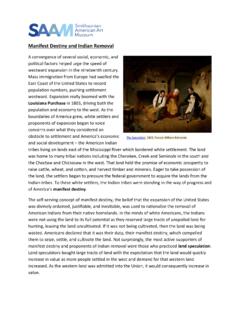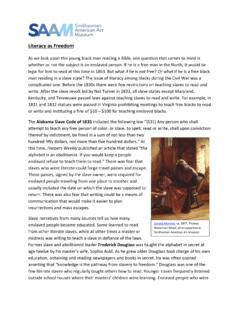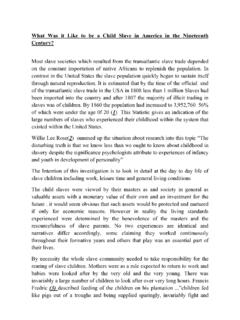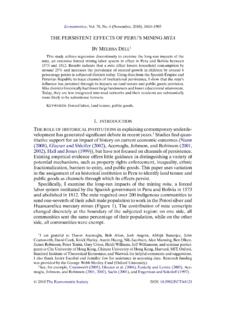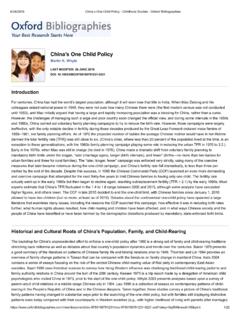Transcription of Alpha Status, Dominance, and Division of Labor in Wolf …
1 Alpha status , dominance , and Division of Laborin Wolf PacksbyL. David Mech1 Abstract: The prevailing view of a wolf (Canis lupus) pack is that of a group ofindividuals ever vying for dominance but held in check by the " Alpha " pair, the alphamale and the Alpha female. Most research on the social dynamics of wolf packs, however,has been conducted on non-natural assortments of captive wolves. Here I describe thewolf-pack social order as it occurs in nature, discuss the Alpha concept and socialdominance and submission, and present data on the precise relationships among membersin free-living packs based on a literature review and 13 summers of observations ofwolves on Ellesmere Island, Northwest Territories, Canada. I conclude that the typicalwolf pack is a family, with the adult parents guiding the activities of the group in adivision-of- Labor system in which the female predominates primarily in such activities aspup care and defense and the male primarily during foraging and food-provisioning andthe travels associated with resource is based on the following source (Northern Prairie Publication 1078):Mech, L.
2 David. 1999. Alpha status , dominance , and Division of Labor in wolf packs. Canadian Journal of Zoology 77 resource should be cited as:Mech, L. David. 1999. Alpha status , dominance , and Division of Labor in wolf packs. Canadian Journal of Zoology 77:1196-1203. Jamestown, ND: Northern Prairie Wildlife Research Center Home Page. (Version 16 MAY2000).Table of Contents Introduction Methods Results and Discussiono Alpha Statuso dominance and submission among pack memberso dominance between the breeding male and femaleo Conclusions Acknowledgements ReferencesTables Table 1 - dominance interactions, in the Ellesmere Island wolf pack, betweenbreeders when no auxiliaries were present. Table 2 - dominance interactions, in the Ellesmere Island wolf pack, amongbreeders and yearlings in 1993.
3 Table 3 - dominance interactions, in the Ellesmere Island wolf pack, amongbreeders and yearlings in 1998. Table 4 - dominance interactions, in the Ellesmere Island wolf pack, amongbreeders and 2-year-old wolves in 1994. Table 5 - dominance interactions, in the Ellesmere Island wolf pack, amongbreeders and a post-reproductive female in 1990 and 1991. Table 6 - Observed attempts to defend food from packmates in the EllesmereIsland wolf Biological Resources Division , Geological Survey, Northern Prairie WildlifeResearch Center, 8711 37th Street SE, Jamestown, ND 58401-7317, address: North Central Research Station, 1992 Folwell Avenue, St. Paul, MN55108, (e-mail: (Canis lupus) packs have long been used as examples in descriptions of behavioralrelationships among members of social groups.)
4 The subject of social dominance andalpha status has gained considerable prominence (Schenkel 1947; Rabb et al. 1967; Fox1971b; Zimen 1975, 1982), and the prevailing view of a wolf pack is that of a group ofindividuals ever vying for dominance but held in check by the " Alpha " pair, the alphamale and the Alpha female (Murie 1944; Mech 1966, 1970; Haber 1977; Peterson 1977).Most research on the social dynamics of wolf packs, however, has been conducted onwolves in captivity. These captive packs were usually composed of an assortment ofwolves from various sources placed together and allowed to breed at will (Schenkel1947; Rabb et al. 1967; Zimen 1975, 1982). This approach apparently reflected the viewthat in the wild, "pack formation starts with the beginning of winter" (Schenkel 1947),implying some sort of annual assembling of independent wolves.
5 (Schenkel did considerthe possibility that the pack was a family, as Murie (1944) had already reported, but onlyin a footnote.)In captive packs, the unacquainted wolves formed dominance hierarchies featuring Alpha ,beta, omega animals, etc. With such assemblages, these dominance labels were probablyappropriate, for most species thrown together in captivity would usually so nature, however, the wolf pack is not such an assemblage. Rather, it is usually a family(Murie 1944; Young and Goldman 1944; Mech 1970, 1988; Clark 1971; Haber 1977)including a breeding pair and their offspring of the previous 1-3 years, or sometimes twoor three such families (Murie 1944; Haber 1977; Mech et al. 1998).Occasionally an unrelated wolf is adopted into a pack (Van Ballenberghe 1983; Lehmanet al.)
6 1992; Mech et al. 1998), or a relative of one of the breeders is included (Mech andNelson 1990), or a dead parent is replaced by an outside wolf (Rothman and Mech 1979;Fritts and Mech 1981) and an offspring of opposite sex from the newcomer may thenreplace its parent and breed with the stepparent (Fritts and Mech 1981; Mech and Hertel1983).Nevertheless, these variations are exceptions, and the pack, even in these situations,consists of a pair of breeders and their young offspring (Mech 1970; Rothman and Mech1979; Fritts and Mech 1981; Mech and Hertel 1983; Peterson et al. 1984). The packfunctions as a unit year-round (Mech 1970, 1988, 1995b).As offspring begin to mature, they disperse from the pack as young as 9 months of age(Fritts and Mech 1981; Messier 1985; Mech 1987; Fuller 1989; Gese and Mech 1991).
7 Most disperse when 1-2 years old, and few remain beyond 3 years (Mech et al. 1998).Thus, young members constitute a temporary portion of most packs, and the only long-term members are the breeding pair. In contrast, captive packs often include membersforced to remain together for many years (Rabb et al. 1967; Zimen 1982; Fentress et ).Attempting to apply information about the behavior of assemblages of unrelated captivewolves to the familial structure of natural packs has resulted in considerable an approach is analogous to trying to draw inferences about human familydynamics by studying humans in refugee camps. The concept of the Alpha wolf as a "topdog" ruling a group of similar-aged compatriots (Schenkel 1947; Rabb et al. 1967; Fox1971a; Zimen 1975, 1982; Lockwood 1979; van Hooff et al.)
8 1987) is wolves have been persecuted for so long (Young and Goldman 1944), they havebeen difficult to study in the wild (Mech 1974) and therefore information about the socialinteractions among free-living wolf pack members has accumulated slowly. Little isknown about the interactions between breeding males and breeding females under naturalconditions, and about the role of each in the pack and how dominance relates to few people have observed the social behavior of wild wolves around dens, but Murie(1944) gave an anecdotal account, Clark (1971), in an unpublished thesis, presented onlya quantified summary of the pack's hierarchical relationships, and Haber (1977) describedhis interpretation of a pack's social hierarchy but gave no supporting evidence. Thus, noone has yet quantified the hierarchical relationships in a wild wolf I attempt to clarify the natural wolf-pack social order and to advance our knowledgeof wolf-pack social dynamics by discussing the Alpha concept and social dominance andby presenting information on the dominance relationships among members in study was conducted during the summers of 1986-1998 on Ellesmere Island,Northwest Territories, Canada (80 N, 86 W).
9 There, wolves prey on arctic hares (Lepusarcticus), muskoxen (Ovibos moschatus), and Peary caribou (Rangifer tarandus pearyi),and live far enough from exploitation and persecution by humans that they are relativelyunafraid of people (Mech 1988, 1995a). During 1986, I habituated a pack of wolves thereto my presence and reinforced the habituation each summer. The pack frequented thesame area each summer and usually used the same den or nearby dens. The habituationallowed me and an assistant to remain with the wolves daily, to recognize themindividually, and to watch them regularly from as close as 1 m (Mech 1988, 1995a;National Geographic Society 1988).We noted each time a wolf submitted posturally to another wolf. Usually this deferencewas characterized by "licking up" to the mouth of the dominant animal in the "activesubmission" posture (Fig.)
10 5 in Schenkel 1967), similar to that described by Darwin(1877) for domestic dogs. Often this behavior took place as an animal returned to the denarea after foraging, and sometimes the returning individual disgorged food to thesoliciting wolf (Mech 1988; Mech et al. 1999). Other behavior noted included "pinning,"or passive submission (Schenkel 1967), in which the dominant wolf threatened another,which then groveled, and "standing over," in which one wolf stands over another, whichoften lies nonchalantly but in a few cases sniffs the genitals of the other. I did notconsider "standing over" a dominance behavior ( Mech, submitted for publication). 2 The following is a summary of generalizations documented in the previous references,together with new quantified status " Alpha " connotes top ranking in some kind of hierarchy, so an Alpha wolf is by definitionthe top-ranking wolf.

